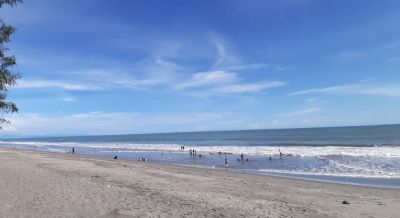
Proteksi Lingkungan dan Efisiensi Sumber Daya dalam Mewujudkan Pariwisata Berkelanjutan di Kabupaten Padang Pariaman
Abstract
Keywords
Full Text:
PDFReferences
D. Le, N. Scott, and S. Becken, “Tourists’ aesthetic assessment of environmental changes, linking conservation planning to sustainable tourism development,” Journal of Sustainable Tourism, (2019).
X. Jia, “Consideration of the role of tourism environmental protection on the sustainable development of Tourism,” Advances in Engineering Research, vol. 163, pp. 1642–1646, (2018).
E. L. Farafontova, E. S. Shcheblyakov, S. M. Kurbatova, A. A. Kuzhleva, and D. V Rakhinsky, “Problems of environmental protection in the aspect of ecological tourism,” in IOP Conference Series: Earth and Environmental Science, (2020), vol. 548, no. 5, p. 52077.
A. A. Shalbafian and N. Zarandian, “Systematic review of public-private partnership studies in tourism,” urban tourism, vol. 8, no. 1, (2021).
Y. Shi, C. Lu, H. Hou, L. Zhen, and J. Hu, “Linking business ecosystem and natural ecosystem together—A sustainable pathway for future industrialization,” Journal of Open Innovation: Technology, Market, and Complexity, vol. 7, no. 1, p. 38, (2021).
A. Andriansyah, “Impact of environmental policy factors on tourism industry: A study from Indonesia over last three decades,” 670216917, (2019).
L. Hakim, “COVID-19 and the Moment to Evaluate tourism Euphoria, Indonesia,” Journal of Indonesian Tourism and Development Studies, vol. 8, no. 2, pp. 119–123, (2020).
I. G. N. P. Suryanata, “Investment multiplier effect expands tourism destinations,” International Research Journal of Management, IT and Social Sciences, vol. 6, no. 2, pp. 44–51, (2019).
Y. Fitri, Y. Yernawilis, H. Harminto, T. Tashwir, D. Sarianto, and A. Yeka, “Analysis of Tiram Tapakih Community Participation on Rehabilitation of Coastal Ecosystem of Padang Pariaman Regency,” Jurnal Ilmu-ilmu Perikanan dan Budidaya Perairan, vol. 16, no. 1, pp. 1–10, (2021).
B. Arifin, T. Ihsan, O. N. Tetra, N. Nofrita, F. Goembira, and F. Adegustara, “Pengelolaan bank sampah dalam mendukung go green concept di Desa Ulakan Tapakis Kabupaten Padang Pariaman,” Jurnal Hilirisasi IPTEKS, vol. 3, no. 2, pp. 169–178, (2020).
R. Yulastra, Y. Yuliana, and P. Pasaribu, “Pengelolaan Sapta Pesona di Objek Wisata Pantai Arta Indah Kabupaten Padang Pariaman,” Journal of Home Economics and Tourism, vol. 15, no. 2, (2021).
L. He, J. Zha, and H. A. Loo, “How to improve tourism energy efficiency to achieve sustainable tourism: Evidence from China,” Current Issues in Tourism, (2020).
A. R. Moienian, M. M. Rahimi, and R. Peyvandi, “The Role of Iranian Criminal Laws in Development of Tourism,” Journal of Tourism Hospitality Research, vol. 7, no. 3, pp. 49–78, (2020).
L. Leonard and A. Dladla, “Environmental risk management and township tourism development in Alexandra, Johannesburg, South Africa,” in Sustainable Urban Tourism in Sub-Saharan Africa, Routledge, (2020), pp. 59–71.
P. Roe, V. Hrymak, and F. Dimanche, “Assessing environmental sustainability in tourism and recreation areas: a risk-assessment-based model,” Journal of Sustainable Tourism, vol. 22, no. 2, pp. 319–338, (2014).
C. Ezeah, J. Fazakerley, and T. Byrne, “Tourism waste management in the European Union: Lessons learned from four popular EU tourist destinations,” American Journal of Climate Change, vol. 4, no. 05, p. 431, (2015).
N. S. Koski-Karell, “Integrated Sustainable Waste Management in Tourism Markets: The Case of Bali,” Indian Journal of Public Administration, vol. 65, no. 3, pp. 646–660, (2019).
M. Qiang, M. Shen, and H. Xie, “Loss of tourism revenue induced by coastal environmental pollution: a length-of-stay perspective,” Journal of Sustainable Tourism, vol. 28, no. 4, pp. 550–567, (2020).
A. P. Krelling, A. T. Williams, and A. Turra, “Differences in perception and reaction of tourist groups to beach marine debris that can influence a loss of tourism revenue in coastal areas,” Marine Policy, vol. 85, pp. 87–99, (2017).
S. Gössling and P. Peeters, “Assessing tourism’s global environmental impact 1900–2050,” Journal of Sustainable Tourism, vol. 23, no. 5, pp. 639–659, (2015), doi: 10.1080/09669582.2015.1008500.
J. Higham, S. A. Cohen, C. T. Cavaliere, A. Reis, and W. Finkler, “Climate change, tourist air travel and radical emissions reduction,” Journal of Cleaner Production, vol. 111, pp. 336–347, (2016).
P. K. Mishra, H. B. Rout, and A. K. Kestwal, “Tourism-energy-environment-growth Nexus: Evidence from India,” Journal of Environmental Management & Tourism, vol. 10, no. 5 (37), pp. 1180–1191, (2019).
T. Coles, C. Dinan, and N. Warren, “Energy practices among small-and medium-sized tourism enterprises: a case of misdirected effort?,” Journal of Cleaner Production, vol. 111, pp. 399–408, (2016).
Global Sustainable Tourism Council, GSTC Destination Criteria with Performance Indicators and SDGs, 2nd ed. Washington, DC: GSTC, (2019).
C. J. Mclennan, S. Becken, and K. Stinson, “A water-use model for the tourism industry in the Asia-Pacific region: The impact of water-saving measures on water use,” Journal of Hospitality & Tourism Research, vol. 41, no. 6, pp. 746–767, (2017).
DOI: https://doi.org/10.24036/cived.v8i3.115790
Copyright (c) 2021 Nofriya Nofriya, Ahmad Fadhly

This work is licensed under a Creative Commons Attribution 4.0 International License.